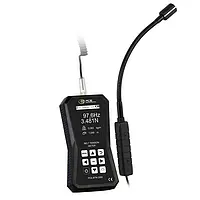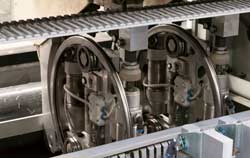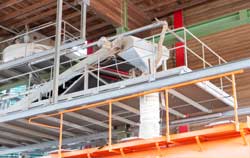




Memory for 750 measurement values / graphic display / simple operation / multilingual menu / measurement in Hz and N

The Condition Monitoring Belt Tension Meter can measure both the belt tension of timing belts and V-belts. Belt tension is an important parameter for the installation, setting up, maintenance and repair of the belt drives. The belt tension should be checked regularly over the entire running time and adjusted if necessary to ensure the maximum service life of all the machine components. It is important that the preload force is selected according to the forces to be transmitted. Principally here applies, the greater the forces to be transmitted and the greater the belt speed during operation, the greater the preload forces that must be selected. At the same time, it is necessary to ensure that the belt tension is not set too high, since otherwise the bearings of the belt drives can be affected and, at the same time, the belt-wear increases which may lead to the belt cracks. At the same time, too low belt tension can also cause damage when, for example, teeth skipping or the belt slipping occurs. That is why it is most important to determine the belt tension or the preload force with a Condition Monitoring Belt Tension Meter. This may help to significantly reduce the follow-up costs occurring due to the unplanned standstill and downtime caused by the bearing damage or by the defective belts. The use of a Condition Monitoring Belt Tension Meter is therefore suitable for applications in the field of motor technology, industrial production, for stepper motors, in tool and machine construction or also in the area of maintenance and repair.

Long service life and high performance of the equipment, machines and devices – is the wish-goal of every user, either company or an individual. In many industries, in particular, in various mechanisms, belts are an important and necessary part. The smallest deviations from the norm may lead to serious consequences, like systems failure, that is why, it is especially important to regularly check the belt tension, since only when this value is absolutely correct and optimal, the best performance may be provided. Not only weaker than necessary tension, but also the tension that exceeds the norm, may cause serious and, which is important, preliminary, degradation of the belt and drop of the performance. For example, wrong belt tension in the generator of the car is devastating in both cases and may be dangerous and lead to the complete wear of the mechanisms. Significant costs – is just one of the items in the list of the possible problems that may follow. Even if the belt is not broken, the change in its function does not remain unimportant for the whole system or mechanism, and that is why it is actually one of the priority tasks to keep this issue under control.
To do this is easy with the help of the belt tension meter, which represents a small, but a very useful device which can help the user to determine the belt tension in the system to be controlled and thus, indicate whether the prompt measures should be taken to adjust the tension to the setpoint value. Even though the measurement of the belt tension requires responsibility, precision and accuracy, the task for the user is significantly facilitated, due to the design and specifications of the device.
The belt tension meter is digital and the sensor which is attached to the gooseneck of the device carries out the main measurement based on the sound wave that the belt produces. Testing the tension manually remained in the past long time ago, and the best way to determine the tension is to use the device and by means of the calculations get an exact data about the belt tension in each particular case. The vibrations coming from the belt are not only registered by the meter, the data are processed after they have been received by the sensor, and based on the characteristics of the belt (weight, width, length), the final result is calculated and displayed on the lighted screen (in Newton / Hz).
The spectrum of application is quite wide, starting from the individual applications in household (various devices and household equipment) or office to industrial fields (different conveyors, lifting equipment, elevators, automotive industry, agricultural machines).
The advantage of the application of the belt tension meter is not only that it helps to detect the faults and prevent failures, it may also be used for checking the correctness of the installation before commissioning. Thus, before the equipment gets started, the check by means of the belt tension meter is a reliable confirmation that the machine will run flawlessly in compliance with the regulations. The data received with the help of the meter may be saved and used as a norm-sample during the regular maintenance checks later. After the measurement in real time, the data does not get lost and may be stored in the device for the coming measurements.
When it goes about belts it goes about many things: heavy loads, speed, vibration, performance, protection of the other mechanisms from overload, etc., but the main point that should be forgotten is safety. Application of the belt tension meter is a good way to perform modern technical service and diagnostics of the faults and mechanical/technical problems.
| Measuring range |
10 ... 900 Hz |
| Accuracy | ± (1% of rdg. + 4 digits) |
| Repeatability accuracy |
± 1 Hz |
| Resolution | <100 Hz: 0.1 Hz |
| >100 Hz: 1 Hz | |
| Belt length | max. 9,999 m |
| Belt mass | max. 9,999 kg/m |
| Sensor length | 25 cm / 9,8 in |
| Memory | 750 measured values |
| 15 sets of 50 measuring points | |
| Menu languages | German, English, Spanish, |
| French, Italian, Dutch | |
| Power supply |
3 x 1.5 V AA batteries |
| Operating conditions | 0 ... 50 °C / 32 ... 122 °F; max. 95 % R.H. |
| Storage conditions | -20 ... 65 °C / -4 ... 149 °C; max. 95 % R.H. |
| Dimensions | 150 x 80 x 38 mm / 5.9 x 3.1 x 1.4" |
| Weight | ca. 200 g / 7 oz incl. batteries |